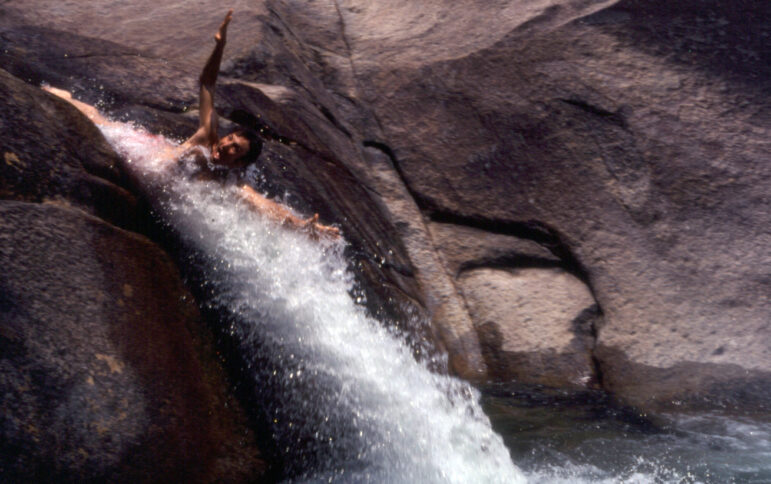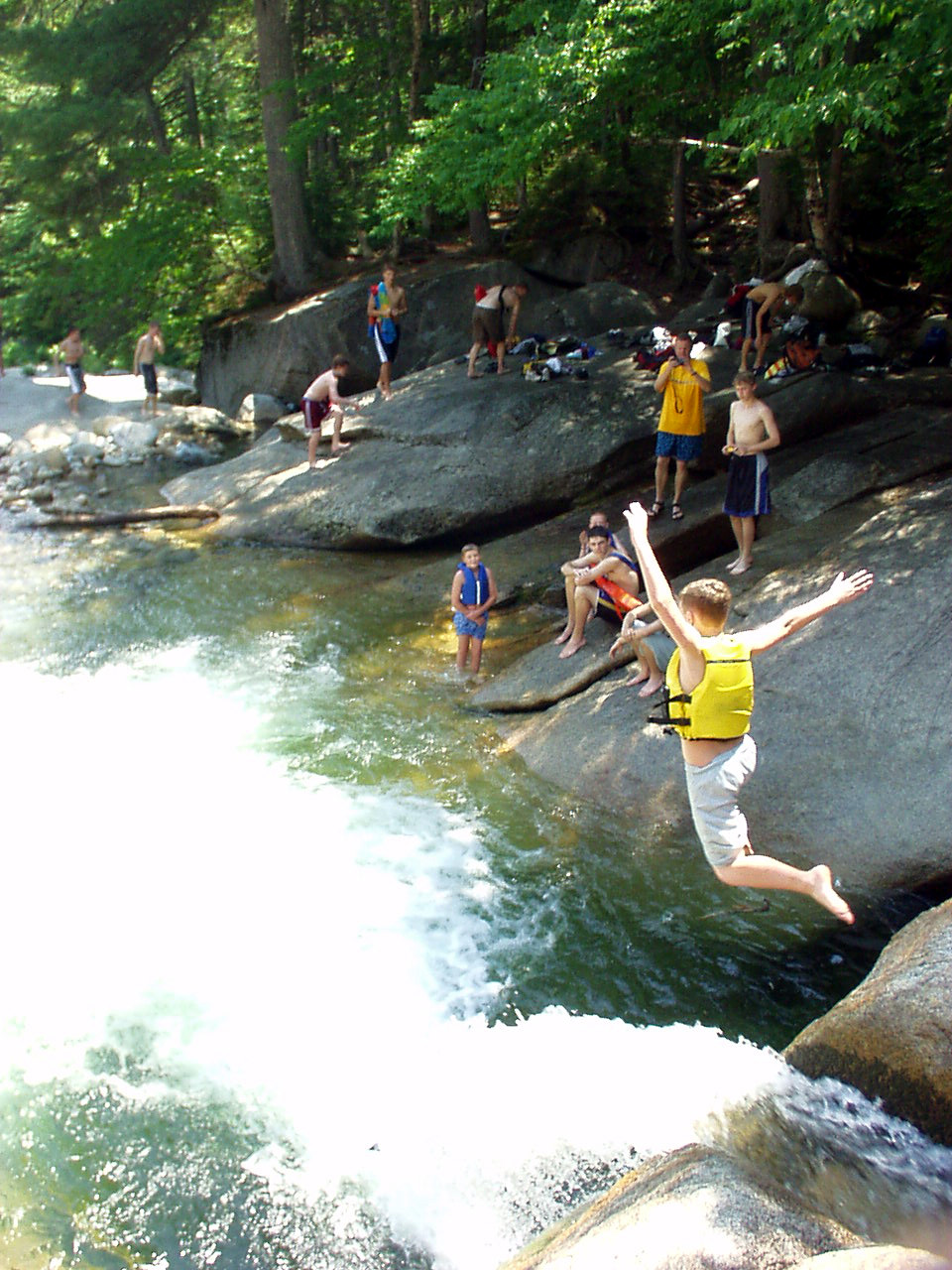
Above, The author at Franconia Falls (circa 1980) Photo by Leigh Goehring
Editor’s note: Please share this with all your friends and family this holiday weekend.
Ruminations from an Unabashed Optimist, an Environmental Patriot and a Radical Centrist
Closely supervise everyone, especially children, and the joys of the outdoors will be your treasured memories for life.
By Wayne D. King, The View from Rattlesnake Ridge
As a guide in the White Mountains in my early life I spent a great deal of time worrying about the safety of my charges. Of course, there are plenty of dangers to be aware of when you are hiking, climbing or paddling in the outdoors but few present the immediate dangers to people more than those associated with water, specifically rivers but also lakes, ponds and the ocean.
It may be because I read InDepthNH.org daily, but there seem to have been more than the usual number of accidental drownings this year.
Perhaps it’s because some of them occurred at places close to my heart, often places where I have been involved, or witnessed, a few close calls myself over the years that I feel compelled to offer some advice and observations to help you stay safe in the waters of New Hampshire.
Although summer is nearly over, it could be said that this shoulder season is the most dangerous of all. The waters are growing colder and cold water leads to exhaustion and panic of swimmers much more quickly than warmer waters. Sunny days may be deceiving as well because we tend to dress (or undress as the case may be) for the day’s temperature not the water temperature and an accidental fall into the water can cause a tragedy for an unexpecting victim.
The rainy nature of the weather this summer has also led to much higher water levels which is particularly dangerous in swiftwater areas, like Franconia Falls where one death recently occurred.
My first water rescue, according to my cousin Mark, was at the ripe old age of 7 when I was the first to notice that he was in distress at the Eddy on the Mad River. Mark still claims that I saved him that day, but my actions probably were more a matter of drawing the adults’ attention to the emergency than anything else.
Later on, those efforts were more serious. I did a quick count in my head as I was writing this piece and believe that I can safely say that I have been involved in at least ten incidents, at Franconia Falls alone, over the years, where a drowning – and in one case a multiple drowning – was averted because we were prepared for an emergency and were able to respond in a matter of moments to it.
- Learn to Swim
So let’s start with some general advice from our friends at the American Red Cross. No need to reinvent the wheel when it comes to succinctly hitting the high points. The Red Cross has prevented hundreds of thousands of tragedies, perhaps more, over the years through their sound advice and rigorous swimming standards and training programs.
You may be one of those rare parents who really can teach their children to swim and swim safely, but the likelihood that you are substituting ego for good judgment is, alas, quite high. Ahem, especially if you are male. It’s purely anecdotal but I find that the ego issue among the male population is especially high. Sorry, not sorry. I’ve been certified at every level with the American Red Cross and I still would not have tried to train my son, nieces or nephews to swim. Take a quick look at the requirements for the various levels of competency if you still think you can do this yourself.
I recently spoke with Frank Hubbard, who was my swimming instructor as a young boy, about the program he established at Mowglis, School of the Open, a summer camp for boys on Newfound Lake. According to him, Frank followed the ARC program to the letter in those first few years and has never seen reason to change that practice even though he taught swimming at every level, including college, over the years.
At the very least make sure that the instructor and program you choose to teach you or your children is certified by the Red Cross.
- Employ layers of protection.
This is more a theoretical construct than a fashion statement.
Begin by having the most advanced swimmer and responder do a preliminary scouting of the water. This scouting of a river or a beach presents a powerful teachable moment as well; by allowing the leader to actually show both adults and children the points of hazard and discuss potential responses to them. This is especially important to those who are canoeing or kayaking on swiftwater or swimming in areas like Franconia Falls.
My good friend and Whitewater Hall of Famer, Charlie Walbridge, taught me that if you capsize a boat in whitewater you get behind the boat, feet first and never try to stand – but ride the rapid out. Abandon the boat if there’s any question, your life is more important than your boat.
Employ barriers to prevent access to water where appropriate. Whether you are on the beach or rocks, place adults between children and water and always be clear about which adult is “on watch” at any particular moment. Of course, make it clear to children that approaching the water should only be done with an adult.
Use life jackets liberally. We all know that life jackets are required in a boat of any kind, even here in the “live free or die state” legislators have had the good sense to require this. But in the ocean and especially in swift water areas they should be a part of the swimming couture for non-swimmers or beginning swimmers. Call it the belt and suspenders approach, accidents are almost always a result of a careless moment gone awry. If a child, or a non-swimming adult has a life jacket on at the very least moments are added to the opportunity for response.
Employ the use of emergency equipment. I note that I often see the adult “lifeguards” for camps, schools or youth groups, these days, bearing brightly colored life belts that can be thrown to a struggling swimmer. I would invariably pack a lightweight safety rope in my backpack that can also be tossed to a struggling swimmer. In a pinch, I’ve even found a long branch that can extend the length of your reach. All of these things employ the old lifesaving mantra: “reach, throw, row, go” outlining the hierarchy of emergency response that maximizes safety and minimizes the personal risk of adding yourself to the mix of victims in crisis.
- Finally, know what to do in a water emergency – including how to help someone in trouble in the water safely, call for emergency help and CPR. CPR does not take long to learn and every adult should know it. I have used it 5 times in my life and it made the difference between life and death in every case.
Every child should learn to swim and if you are swimming in an area where special conditions exist, like rip tides in the ocean, pay attention to signage and take it seriously.
There are few things in life more thrilling than swimming in rivers. Riding the water sluice of Franconia Falls over the falls and into the deep pool below is an unforgettable life experience. Taking a little time to make sure that you are safety conscious will make the difference between a lifelong memory and a tragedy.
Links:
Find Red Cross Swimming instruction near you.
About Wayne D. King: Author, podcaster, artist, activist, social entrepreneur and recovering politician. A three-term State Senator, 1994 Democratic nominee for Governor. His art (WayneDKing.com) is exhibited nationally in galleries and he has published five books of his images, most recently, “New Hampshire – a Love Story”. His novel “Sacred Trust” a vicarious, high voltage adventure to stop a private powerline as well as the photographic books are available at most local bookstores or on Amazon. He lives on the “Narrows” in Bath, NH at the confluence of the Connecticut and Ammonoosuc Rivers and proudly flies the American, Iroquois and Abenaki Flags. His publishing website is: Anamaki.com.
Podcasts are produced at Anamaki Studios in Bath, NH.
This land lies in N’dakinna, the traditional ancestral homeland of the Abenaki, Sokoki, Koasek, Pemigewasset, Pennacook and Wabanaki Peoples past and present. We acknowledge and honor with gratitude those who have stewarded N’dakinna throughout the generations.
Wayne D. King
64 Monroe Rd., Bath, NH 03740
603-530-4460 Cell
waynedking9278@gmail.com
www.Anamaki.com : Productions & Studios
www.WayneDKing.com : Fine Art





